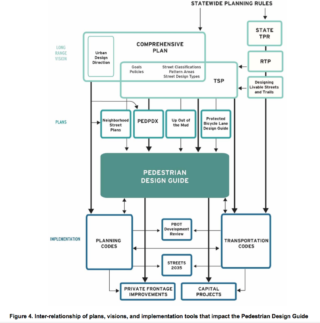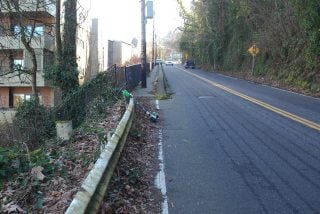
In Portland we drink from the punch bowl called Planning — the 2035 Comprehensive Plan, the Bicycle Plan for 2030, PedPDX, and the various “in Motions” (north Portland being the latest). The Portland Bureau of Transportation (PBOT) Planning department also has a hand in large capital projects funded by the public which showcase our transportation values, like the Ned Flanders pedestrian and bike bridge and the SW Capitol Highway Project to name a couple.
So it’s understandable that many of us think Portland’s transportation network gets built with capital projects guided by Planning.
But there’s another important PBOT department which gets less attention from transportation activists, it’s called Reality Check — I mean, Development Review. They work with private developers to ensure that private right-of-way and frontage work meets code and various guidelines and standards. City ordinance requires frontage improvements as part of development, and many of the city’s sidewalks and frontages have been built privately, so Development Review is an important group that can pass under the radar.
The folks at Development Review have a stressful job. They are the interface between transportation advocates and neighborhood associations (who have suckled on the steady flow of aspirations from Planning) and private developers who may not want to be on the hook for the bill.
Looking the problems square-on is the first step to solving them.
This natural tension between Planning and Development Review is one lens through which to view the long-awaited Pedestrian Design Guide (PDG) update, which is due any day now. The PDG is the city’s “primary guidance on how sidewalks should be built throughout Portland to ensure they are context-appropriate and accessible to people of all ages and abilities,” and it was last updated 23 years ago. Since that time, Portland has grown by 100,000 people and “additional plans, policies and procedures . . . make implementing the PDG confusing for staff.” Hence the current update.
While awaiting the PDG release, I have found myself buried in a fascinating memorandum on the project website titled, the Pedestrian Design Guide Focus Group & Peer City Review Memo. It’s a straightforward document written by the transportation consultants Toole Design for the planners tasked with updating the PDG. If you want an unadulterated view into the mind of a bureaucracy, this is it.
The document falls into two sections: focus group summaries from the various in-house users of the PDG, and reviews of five peer cities (Seattle, Washington DC, Denver, Boston and Austin), “to get a sense of how other cities are working to create their ideal sidewalk corridors.”
Development Review is the primary customer of the PDG, and their focus group lays bare the tight space they navigate between transportation ideals and what improvements they can ask developers to make. They request the city “make a side effort to ‘sunset’ any outdated rules or policies to ensure that there would not be any conflicts that could be cited by developers.”

They also ask for “flexibility” when trade-offs need to be made. Development Review often finds itself between a hard place (like a basalt rock face) and a gulch, where the ROW is “constrained,” especially in southwest Portland. The cliff/gulch topography characterizes and constrains most of SW Portland’s main corridors. In practice, the “flexibility” to deal with local conditions sometimes leads to reducing active transportation requirements to pro forma nods toward safety, which don’t actually make the roadway safer for people riding or walking.
The questions are: What will the new Pedestrian Guide recommend in these constrained situations? How committed is Portland to making sure that everyone can use the right-of-way safely and comfortably, including those on foot and bike? What will it recommend for narrow residential roadways?
I’m optimistic. It is a welcome step forward to read documents that don’t shy away from the big issues of stormwater management, legal vulnerability, exceptions to ADA requirements and need for context-sensitive design. Looking the problems square-on is the first step to solving them.

— Lisa Caballero, lisacaballero853@gmail.com
— Get our headlines delivered to your inbox.
— Support this independent community media outlet with a one-time contribution or monthly subscription.
